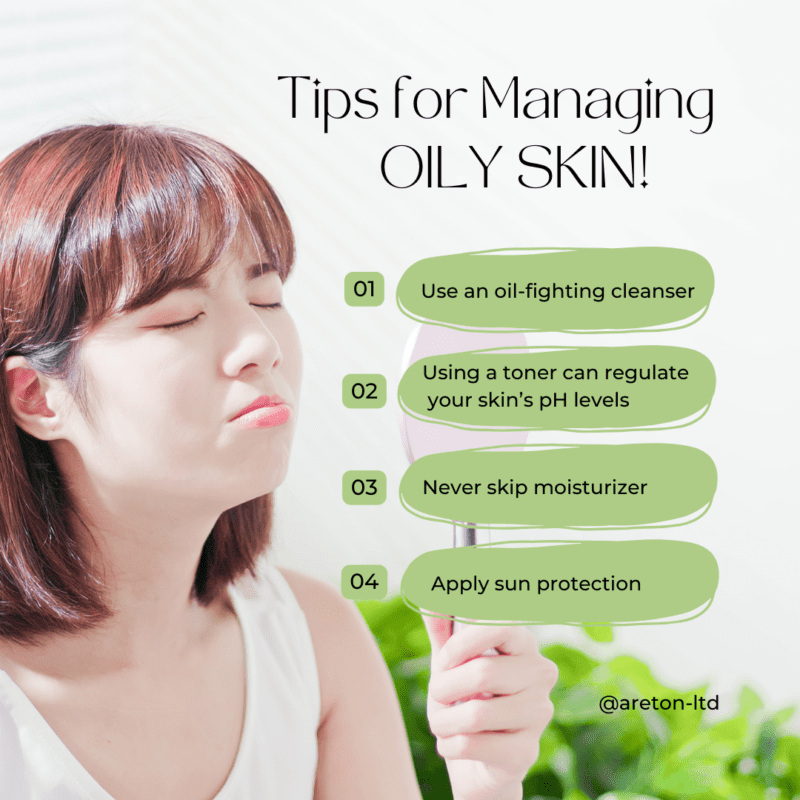Introduction
Oily skin can be a frustrating skin type to manage. It’s characterized by an overproduction of sebum, leaving the skin looking shiny and prone to breakouts. For those struggling with excess oil, the constant need to blot shine and deal with clogged pores can really take a toll. An oily complexion is not easy to tame. However, understanding the causes and exploring the right treatments can help restore balance and achieve a healthy glow.
What is Oily Skin?
Oily skin is characterized by excessive oil production in the skin. The skin has a shiny, greasy appearance and enlarged pores. Oily skin is caused by overactive sebaceous glands in the skin that produce an excess amount of sebum, the oil that lubricates and protects the skin.
Sebum is needed by the skin in healthy amounts, but some people produce too much. This overproduction leads to a buildup of oil on the skin’s surface. Oily skin is common in teenagers and young adults due to hormonal changes during puberty. However, it can affect people of all ages.
The excess oil makes the skin look shiny and greasy, especially on the nose, forehead and cheeks. The skin may feel sticky or tacky to the touch. Enlarged pores are also a hallmark of oily skin. The pores appear bigger because they are clogged with oil and debris.
Oily skin is prone to breakouts and acne since the excess oil can mix with dead skin cells and bacteria, leading to clogged pores and inflammation. Blackheads and pimples often develop. The skin may also feel congested.
While oily skin can be frustrating to manage, it does have some benefits. The increased oil helps retain moisture and creates a protective barrier on the skin. Oily skin also shows signs of aging later since the oil helps keep wrinkles at bay. Still, controlling excess oil is important for clear, healthy skin.
Causes of Oily Skin
Genetics
One of the main causes of oily skin is genetics. Our genes determine the size of oil glands in our skin and how active they are. People with overactive oil glands naturally produce more sebum, the oil that moisturizes and protects the skin. Those with larger oil glands also tend to have oilier skin. Oily skin often runs in families, so if your parents have oily skin, you’re more likely to as well. This genetic predisposition means that some people are simply born with oily skin types. The sebaceous glands are overactive from birth and overproduce sebum, leading to shiny, greasy skin. While genetics play a big role, oily skin can also be influenced by hormones, diet, skincare products and environmental factors. However, for many people, oily skin is primarily caused by their genetic makeup.
Causes of Oily Skin
Hormones
Hormonal changes and imbalances are one of the most common causes of oily skin. The sebaceous glands in the skin produce an oily substance called sebum, which helps moisturize and protect the skin. However, when hormone levels fluctuate during puberty, pregnancy, menstruation, or perimenopause, sebum production can go into overdrive.
The androgens (male hormones) present in both men and women stimulate the sebaceous glands and increase sebum secretion. Higher levels of androgens can lead to excess oil production and cause the pores to become clogged more easily. This is why many teenagers develop oily skin during puberty.
In women, monthly hormonal fluctuations related to the menstrual cycle can also trigger oily skin. Estrogen levels are highest around ovulation, which boosts sebum production. Then, during the days leading up to menstruation, progesterone levels rise while estrogen levels decline. This seesaw effect further stimulates the sebaceous glands. Some women may experience increased oiliness only during certain phases of their cycle.
The hormonal changes associated with pregnancy and perimenopause can also cause oily skin due to the overall increase in hormones. Consulting a dermatologist and using gentle skincare products can help manage hormonal oily skin.

Causes of Oily Skin
Diet
Diet can play a significant role in oil production and the development of oily skin. Foods that are high in fat, sugar, and refined carbohydrates can increase sebum production and cause skin to become oilier. Some specific dietary factors that can contribute to oily skin include:
High glycemic index foods – Foods that cause spikes in blood sugar like white bread, pasta, sugary snacks and beverages can stimulate oil production.
Dairy products – Milk, cheese, cream and other dairy foods contain hormones that can trigger more sebum production. Some people find reducing dairy intake helps control oiliness.
Fried and fatty foods – Foods high in saturated and trans fats like fries, burgers, pizza and baked goods can clog pores and lead to excess oil.
Alcohol – Drinking alcohol, especially in excess, can cause inflammation and dehydration that increases oil production.
Caffeine – Excess caffeine from coffee, tea, soda and energy drinks can also dehydrate skin and stimulate more oil.
Eating a diet focused on lean proteins, complex carbs, healthy fats, fruits, vegetables and staying hydrated can help balance oil production and reduce shine. A balanced, low glycemic diet may be one of the best ways to control oily skin from the inside out.
Causes of Oily Skin
Environment/Climate
The environment and climate can play a major role in contributing to oily skin. Those who live in humid, hot climates are more prone to dealing with excess oil production. The heat and humidity cause the sebaceous glands to work harder to cool the skin down through oil secretion. This leads to increased oiliness, enlarged pores, and a shiny complexion.
People who live in tropical, coastal, or monsoon environments tend to struggle more with oily skin than those in temperate or dry climates. The constant heat, moisture, and humidity stimulate sebum production. Air conditioning can provide some relief by cooling and drying the skin. However, going back out into the heat and humidity causes the oil glands to start working in overdrive again.
Some find that even living in a hot, humid climate part of the year is enough to trigger lasting bouts of oily skin. The skin can get accustomed to ramping up oil production during summer months. Then it struggles to turn down sebum secretion when the weather cools off. This can result in combination skin with an oily T-zone even during winter.
Problems Associated with Oily Skin
Oily skin can lead to a variety of issues if not properly managed. Some of the most common problems associated with oily skin include:
Acne – Excess oil production can clog pores and lead to acne breakouts. Both whiteheads and blackheads are common. The oil provides a breeding ground for acne-causing bacteria.
Blackheads – Dead skin cells and oil build up in pores, forming blackheads. These appear as small black dots on the skin and are a form of mild acne.
Oily Shine – Excess oil on the skin creates a greasy shine, especially across the forehead, nose and chin. This can look unappealing.
Enlarged Pores – With continual excess oil production, pores get stretched out and appear visibly larger over time. This exacerbates other issues like blackheads.
Dull Skin – Too much oil accumulation can make skin look dull rather than glowing. It reflects light differently compared to properly balanced skin.
Makeup Issues – Oily skin can cause makeup to slide off, crease or smear. It makes cosmetics application more challenging.
Properly caring for oily skin is important to minimize these potential problems. This includes using targeted cleansers, exfoliants and topical treatments. Consulting a dermatologist can also help manage more severe oily skin issues.
-
 Rated 0 out of 5¡A la Venta!Add to basket
Rated 0 out of 5¡A la Venta!Add to basket$10.00Original price was: $10.00.$5.99Current price is: $5.99. -
 Rated 0 out of 5¡A la Venta!Add to basket
Rated 0 out of 5¡A la Venta!Add to basket$10.00Original price was: $10.00.$5.99Current price is: $5.99.



